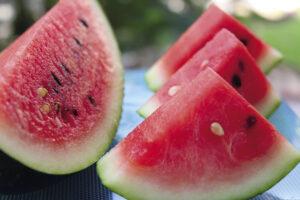Hungarian melons are gaining momentum again: the growing area has increased, exports are strengthening
Although the first melons of this summer have already appeared on store shelves – even at prices of 800–1200 forints per kilo – domestic producers are now preparing for the real start of the season. Despite the difficulties, Hungarian melon production has gradually started to grow: the area under cultivation has increased for both watermelon and cantaloupe, and the expected yield far exceeds domestic consumption – writes Agrárszektor.
Growing area, stabilizing sector
 The year 2024 brought a favorable turn for domestic melon growers: a 10% area increase was achieved in the case of watermelon, so that this year cultivation is already underway on 3700 hectares. In the case of cantaloupe, an even more significant 15% expansion was registered, so that this sweet-fleshed variety was planted on almost 500 hectares. The largest production areas are still concentrated in Eastern Hungary: 1,320 hectares are used for melons in Békés County, while a total of 1,350 hectares are used for melons in the eastern region. Heves County is also a significant player with 377 hectares.
The year 2024 brought a favorable turn for domestic melon growers: a 10% area increase was achieved in the case of watermelon, so that this year cultivation is already underway on 3700 hectares. In the case of cantaloupe, an even more significant 15% expansion was registered, so that this sweet-fleshed variety was planted on almost 500 hectares. The largest production areas are still concentrated in Eastern Hungary: 1,320 hectares are used for melons in Békés County, while a total of 1,350 hectares are used for melons in the eastern region. Heves County is also a significant player with 377 hectares.
The frost damage experienced in the spring of 2024 also played a role in the structural transformation of production: several fruit growers planted melons – mainly cantaloupe – in place of the damaged plantations, thus diversifying production risks.
There will be plenty of supply – both at home and abroad
The expected harvest could reach 170–180 thousand tons, while domestic consumption continues to be around 110–120 thousand tons per year. This means that Hungarian melons can not only satisfy domestic needs, but also offer significant export opportunities.
International markets remain stable, but competition is intensifying: in addition to traditional southern European (Spanish, Italian) competition, Moroccan melons are also playing an increasingly prominent role in Europe. In order to maintain and expand foreign market positions, cooperation between producers and the strengthening of producer organizations are increasingly important.
An expensive melon or a promotional attraction?
For now, it is difficult for consumers to navigate the prices: while some supermarket chains offer watermelons at a discount price of 265 forints, in others they can cost 800–1200 forints per kilo – a larger piece can thus cost up to 10–12 thousand forints. The wide price range may also be a consequence of the different origin, quality and size of products, as well as the positioning at the beginning of the season.
According to producers, more balanced and affordable prices are expected in the second half of the summer, especially if domestic supply arrives on the market in large quantities.
Related news
Univer is building on export-led growth
🎧 Hallgasd a cikket: Lejátszás Szünet Folytatás Leállítás Nyelv: Auto…
Read more >Hungarian exports are gaining new momentum: medium-sized companies are increasingly managing exchange rate risk and opening up to new markets
🎧 Hallgasd a cikket: Lejátszás Szünet Folytatás Leállítás Nyelv: Auto…
Read more >KSH: the foreign trade surplus in goods was 713 million euros in October; the volume of exports was 3.1 percent lower, and that of imports was 1.1 percent higher than in the same period of the previous year
🎧 Hallgasd a cikket: Lejátszás Szünet Folytatás Leállítás Nyelv: Auto…
Read more >Related news
CDs and DVDs are experiencing a renaissance at Vatera, but second-hand LEGO is the real star of this Christmas
🎧 Hallgasd a cikket: Lejátszás Szünet Folytatás Leállítás Nyelv: Auto…
Read more >Christmas tree shopping is also going digital: demand for online ordering is growing rapidly
🎧 Hallgasd a cikket: Lejátszás Szünet Folytatás Leállítás Nyelv: Auto…
Read more >NGM and VOSZ cooperation agreement for the security of digital commerce
🎧 Hallgasd a cikket: Lejátszás Szünet Folytatás Leállítás Nyelv: Auto…
Read more >






